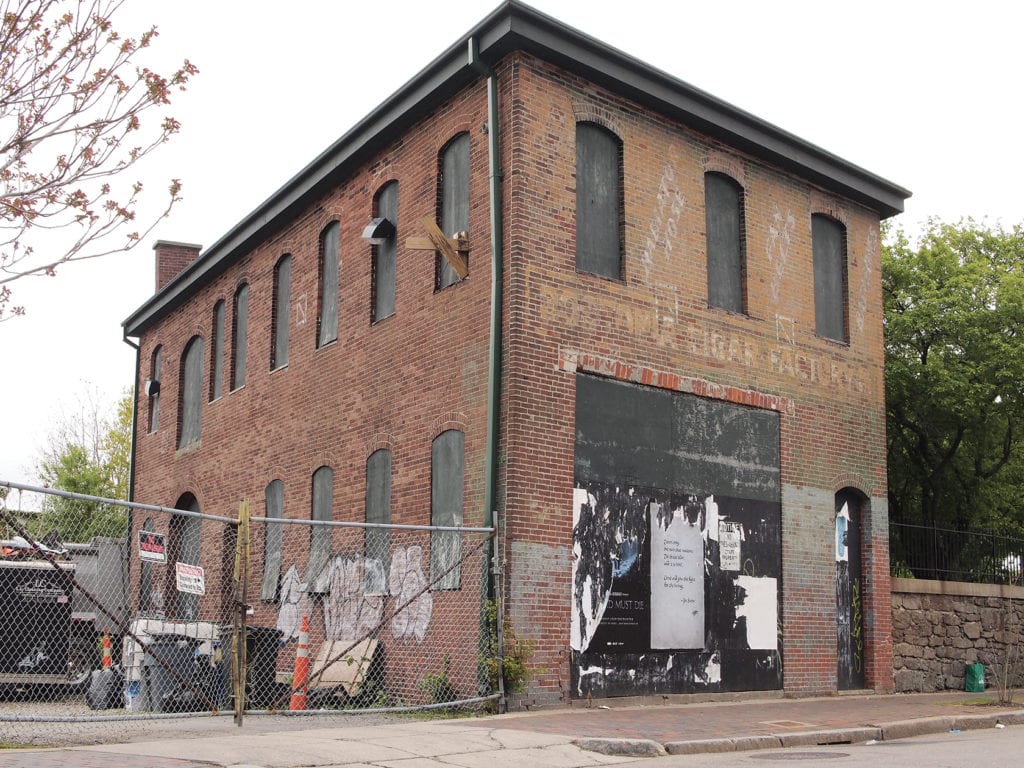City to seek bids for Nawn Factory
Historic 19th century building will be part of larger Dudley Square parcel

When the Owen Nawn Factory was first built around 1880, it was leased to Chesley Brothers, a firm that sold hay, straw, grain and flour. Now, the long-vacant brick building is being looked at as a potential cultural entryway into Roxbury’s Dudley Square.
The Boston Planning and Development Agency, as part of its PLAN: Dudley redevelopment program, will soon be releasing a request for proposals for the site containing the factory. Known as Parcel 8, the site makes up part of the square bordered by Washington Street, Melnea Cass Boulevard, Harrison Avenue and Eustis Street, adjacent to the historic Eliot Burying Ground. The agency will also issue an RFP for the Blair Lot, across Eustis Street from Parcel 8.
“The BPDA is looking forward to community engagement around these two properties, and utilizing the public land for the public good that’s been envisioned by the community members over the last couple years,” said Devin Quirk, director of real estate at the BPDA.
Nawn Factory history
The factory, located at 2080 Washington St., is a large two-story brick building, but when it was built, it was about three times larger, spanning a total of approximately 10,000 square feet. Tenements were built on the site near the rear of the building, and a candlemaking shop and barn owned by Josiah Cunningham once stood next to it. A cobblestone street once leading to Harrison Avenue was known as Nawn Street, because of the factory and surrounding buildings owned by Owen Nawn.
After the Chesley Brothers, the factory was leased by Cole Brothers, which used it for the same purposes, until 1891. Other tenants included Brandenburg and Martin cabinetmakers from 1883 to 1886, Wilson Brothers carpenters from 1891 to 1903, and a farrier named Dr. White from 1887 to 1888. Shorter-term occupants in that time included a cigar manufacturer, a blacksmith, a house painter, a stable and the medical department of the Fire Department, which was nearby in the still-standing 20 Eustis St. Firehouse.
Nawn sold the factory in 1898.
In the 20th century, the factory housed locksmith and bellhanger Alexander Blackwood until 1911, as well as cigar makers, auto parts and tires, upholstery manufacturing and office space; it was later a warehouse in the 1960s, but has been vacant for many years.
“The Nawn Factory appeared on our most threatened list of historic buildings back in 1985,” said Kathy Kottaridis, executive director of Historic Boston Incorporated. “It’s been on our radar screen for a long time.”
Kottaridis explained that HBI, which is headquartered in the former Eustis Firehouse, sees the factory, the 17th-century burying ground, the firehouse and the other surrounding buildings as one historic site to be protected and preserved.
“They kind of represent a wide period of time in Roxbury history,” she said. “Whatever goes there should be self-sustaining, so it can stand on its own two feet going forward and continue to remind us of the industrial history of Dudley Square, but continue to be useful.”
Redevelopment of the factory and Parcel 8
While the RFP calls for other parts of Parcel 8 and the Blair Lot to be built up as low-income housing, the Nawn Factory presents a more intriguing problem for the BPDA: How can it be preserved while making it useful to the public?
The agency has a grant from the federal government to redevelop the historic building, but the grant expires in 2023, so it has to act fast.
Potential ideas that have been suggested include a dance studio, cafe or museum, but the BPDA will be asking the surrounding community for advice on what to do. Before the RFP is released, it will be holding a community meeting from 6-7:30 p.m. on Monday, May 20 at the Boston Water and Sewer Commission, 980 Harrison Ave., to find out what residents want from the building.
Kottaridis said that she hopes the outcome of the development will be some sort of cultural center that celebrates Roxbury’s history.
“It should give people a place to go when they want a welcome to Roxbury,” she said. “And not just for outsiders who are visiting — a place to go to celebrate Roxbury, then and now.”






